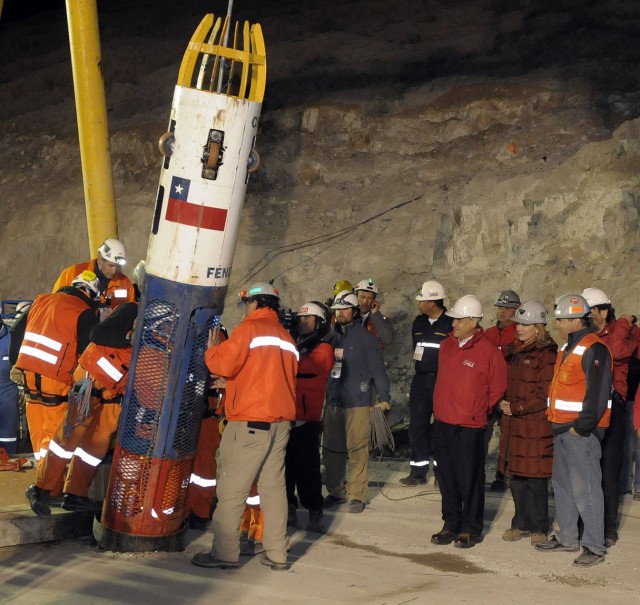
COPIAPO,
local time Wednesday, sounds of rejoicing filled the camp in the
Chilean desert where hundreds of international media were holding vigil
along with family members of 33 gold and copper miners entombed half a
mile below ground.
“I never doubted. I always knew God would rescue us,”
“I am so very happy,” added the miner, who was
surrounded by family members holding his hands or touching him, as if
to be sure he was really there. “I’m 40 years old and will live many
years more now to honor those who helped” in the rescue.
Foreman
the first of the miners to ride up the shaft. Wearing sunglasses to
protect his eyes from aboveground lights, Avalos squeezed into a
specially fitted, bullet-shaped capsule only a shade smaller than the
28-inch diameter of the tunnel and was winched to the surface over 14
agonizing minutes.
He stepped from the capsule to an explosion of
cheers and patriotic chanting from rescue workers and Chilean
officials, his emergence broadcast by state TV to a worldwide audience
witnessing a triumph of human determination over geology.
Amid whistles, raw shouts and tears, Avalos hugged his wife, Monica, his sobbing 7-year-old son, Bairon, and the president of
His appearance signaled the start of the final, still-perilous chapter in a 69-day-old drama that began
when an underground collapse at the mine sealed off exits for the men.
The miners’ location and fate were unknown for 17 days, until a drill
probing for air pockets poked through into a lunchroom where the men
were waiting.
Since then, the original despair above and below
ground gave way to rejoicing at the discovery, followed by anxiety as
drills punched through rock to create a path for the rescue. Patience
was further strained by technical delays on the final day, as crews
hooked up communications gear and ran more tests on the integrity of
the shaft.
But any frustration surrendered to elation when
a technician, descended and joined the men. Video from thousands of
feet underground showed extraordinary scenes of the miners greeting a
visitor from the surface.
Gonzalez’s arrival was proof that the trip could be made, but the drama still has time to run.
Rescue workers drafted a pecking order for the men’s
ascent and said they hoped to bring them out at a rate of about one an
hour, a pace that would have everyone to safety in two days.
But they also cautioned against premature
celebration, noting that only the top of the shaft had been lined with
metal tubing and that each trip required the capsule to negotiate bends
in the crude tunnel.
Pinera had arrived at the mine Tuesday afternoon to watch the rescue efforts and greet the miners.
“We made a promise to never surrender and we kept it,” the president said.
As relatives huddled around television sets or
bonfires waiting for details about when their loved ones were to be
hoisted up aboard the rescue capsule, they said they were allowing
themselves to feel an enormous sense of relief.
Juan Alcalipe, whose son-in-law,
30, was among the trapped miners, said he was excited to be so close to
the end of a nightmare. Araya, he said, won’t be returning to work at
the mine.
“My daughter won’t let him,” Alcalipe said.
After Avalos was ushered to a nearby makeshift clinic for a checkup, shower and change of clothes, another rescuer,
Rather than appearing feeble after his long
imprisonment, Sepulveda erupted from the rescue capsule as if he had
scored a winning goal in the World Cup. First he hugged his wife,
Elvira, then he hugged Pinera three times, then he hugged anyone within
reach before leading a crowd of onlookers in a victory chant of “Long
live
reached the top. The third man to be pulled from the ground hugged his
wife, then climbed into a cot to be wheeled away.
The lone Bolivian among the miners,
was the next man lifted to safety. He greeted his wife, Veronica, with
a kiss that knocked off her white hard hat. He then gestured to a
Chilean flag on his T-shirt and shouted, “Gracias,
As the night wore on and all eyes remained on the
spinning wheel that lowered and raised the rescue capsule, the
operation appeared to be running smoothly.
Near the rescue site were four red-and-white
portable structures that served as the clinic where, for the first two
hours above ground, the miners received first aid if needed.
Farther up a steep incline, past enormous cranes and
other equipment used in the effort, were half a dozen container-like
structures where miners were reunited with their families.
While in the metal capsule, the men wear an oxygen
mask, compression socks to prevent blood clots and a belt that
continually measures pulse, temperature and respiration. There is
two-way communication inside, and a small video camera focuses on the
miner’s face.
In the event of signs of panic — the biggest concern of rescuers — the extraction will be speeded up.
———
(c) 2010, Los Angeles Times.
Visit the Los Angeles Times on the Internet at http://www.latimes.com/
Distributed by McClatchy-Tribune Information Services.













